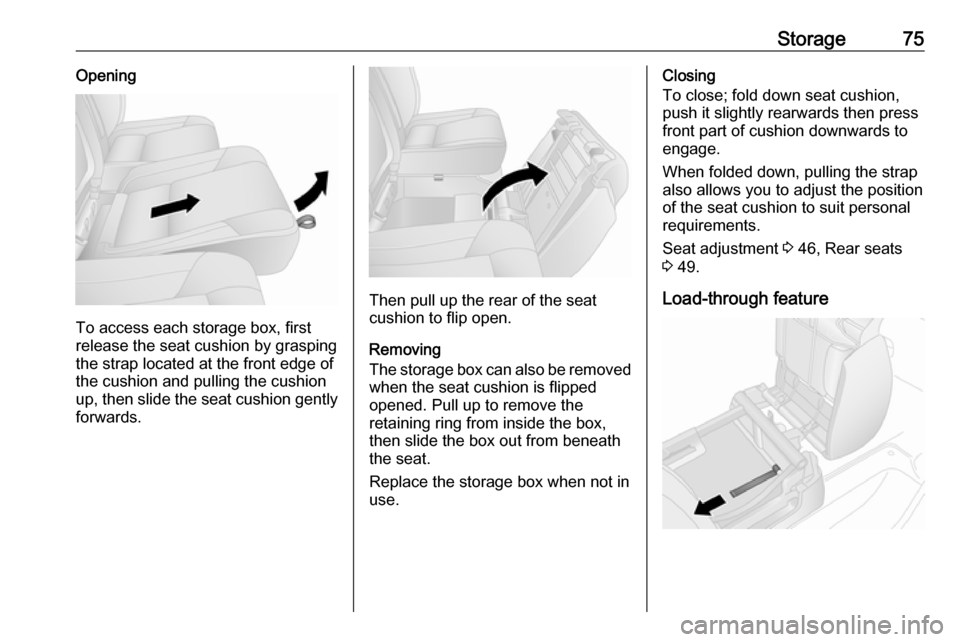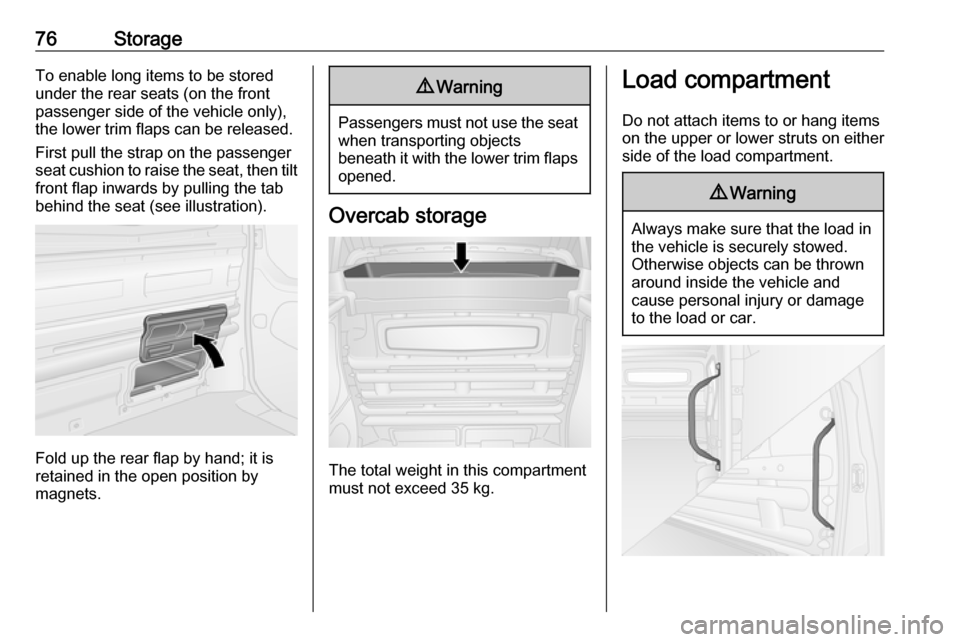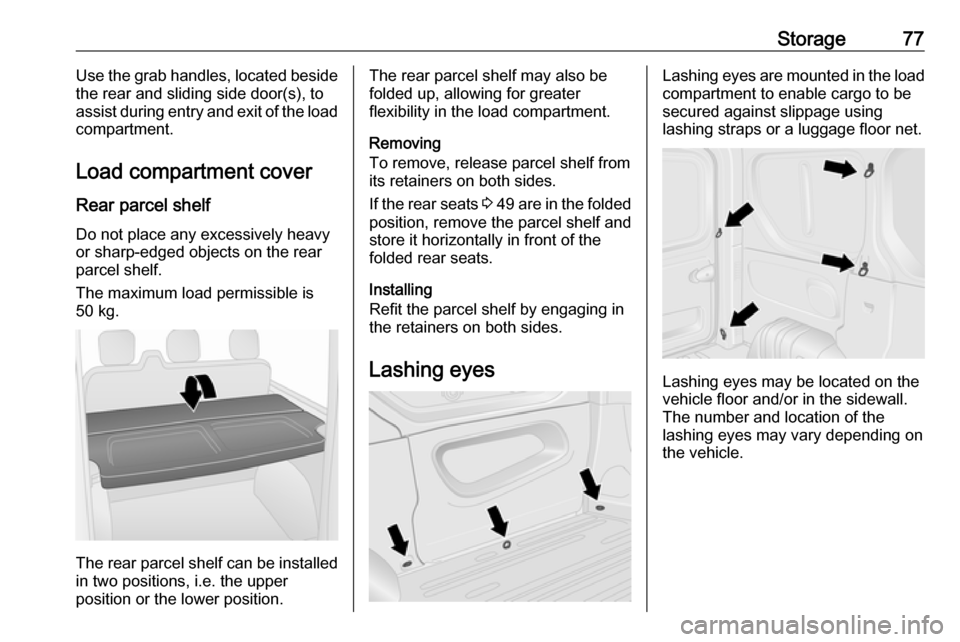VAUXHALL VIVARO 2017.5 Manual PDF
Manufacturer: VAUXHALL, Model Year: 2017.5, Model line: VIVARO, Model: VAUXHALL VIVARO 2017.5Pages: 231, PDF Size: 5.52 MB
Page 71 of 231

Seats, restraints69Permissible options for fitting an ISOFIX child restraint systemWeight classSize
classFixtureFront seats2nd row seats 13rd row seatsCentreOutervehicles with single
passenger seatvehicles with double
passenger seatGroup 0: up to 10 kgEISO/R1XXILILXGroup 0+: up to 13 kgEISO/R1XXILILXDISO/R2XXILXXCISO/R3XXILXXGroup I: 9 to 18 kgDISO/R2XXILXXCISO/R3XXILXXBISO/F2XXIL, IUF 2IL, IUF2XB1ISO/F2XXXIL, IUF2IL, IUF2XAISO/F3XXIL, IUF2IL, IUF 2XGroup II: 15 to 25 kgXXIL, IUF2IL, IUF2XGroup III: 22 to 36 kgXXIL, IUF2IL, IUF 2X
Page 72 of 231

70Seats, restraints1:If necessary, slide adjustable front seat forwards to install a child restraint system on these seats. There may not be
enough clearance to install a child restraint system on vehicles fitted with fixed front seats.2:Forward-facing child restraints: Remove head restraint 3 44 before installing child restraint. The seat in front of this
installation position must not be more than halfway back on its runners. Maximum backrest rake is 25°. Seat adjustment
3 46.IUF:Suitable for ISOFIX forward-facing child restraint systems of universal category approved for use in this weight class.X:No ISOFIX child restraint system approved in this weight class.IL:Suitable for particular ISOFIX restraint systems of the 'specific-vehicle', 'restricted' or 'semi-universal' categories.
The ISOFIX restraint system must be approved for the specific vehicle type.
ISOFIX size class and seat device
A - ISO/F3:Forward-facing child restraint system for children of maximum size in the weight class 9 to 18 kg.B - ISO/F2:Forward-facing child restraint system for smaller children in the weight class 9 to 18 kg.B1 - ISO/F2X:Forward-facing child restraint system for smaller children in the weight class 9 to 18 kg.C - ISO/R3:Rear-facing child restraint system for children of maximum size in the weight class up to 18 kg.D - ISO/R2:Rear-facing child restraint system for smaller children in the weight class up to 18 kg.E - ISO/R1:Rear-facing child restraint system for young children in the weight class up to 13 kg.
Page 73 of 231

Storage71StorageStorage compartments................71
Instrument panel storage ...........71
Glovebox ................................... 72
Cupholders ................................ 73
Front storage ............................. 73
Door panel storage ....................74
Underseat storage .....................74
Overcab storage ........................76
Load compartment .......................76
Load compartment cover ...........77
Lashing eyes ............................. 77
Safety net .................................. 78
Load compartment grille ............79
Warning triangle ........................80
First aid kit ................................. 80
Roof rack system .........................80
Roof rack ................................... 80
Loading information .....................80Storage compartments9Warning
Do not store heavy or sharp
objects in the storage
compartments. Otherwise, the
storage compartment lid could
open and vehicle occupants could be injured by objects being thrown
around in the event of hard
braking, a sudden change in
direction or an accident.
Instrument panel storage
Storage compartments, pockets and
trays are located in the instrument
panel.
A coin holder may be located on the
instrument panel.
A phone holder may be located on the instrument panel.
Page 74 of 231

72Storage
A tablet holder may be located on the
instrument panel.
To use the tablet holder, pull the
handle towards you fully. Swivel
holder and push it in fully. If required, lower the base of the holder to extend
it.
To refit, pull tablet holder fully towards you, lift it up until it is horizontal and
push it in fully.Depending on version, the tray
located on top of the instrument panel
may have a lid.
Glovebox
To open, pull the handle.
Depending on version, the glovebox
may feature a light that comes on
when the glovebox is opened, and
may also be lockable.
The glovebox should be closed while
driving.
Page 75 of 231

Storage73Cupholders
Cupholders are located at both ends
of the instrument panel, centrally in the lower instrument panel, and
depending on version, also in the
door pockets and in the rear seat
area.
Additional cupholders are located on
the back of the folded down centre
rear seat 3 73, 3 49.
The cupholders can also be used to hold the portable ashtray unit.
Remove the portable ashtray unit to
use the cupholders.
Ashtrays 3 88.
Front storage
Coat hooks are located on the cabin
bulkhead and on the grab handles in
the roof lining.
Folding centre seatback The front centre passenger seat
backrest, when folded fully forwards, features a storage compartment,
cupholder and a document tray.
Seat folding 3 48.9 Warning
When the front centre passenger
seat is in the folded position, the front passenger airbag system
must be deactivated.
Airbag deactivation 3 62.
Close the instrument panel cupholder
before folding down the backrest.
Press button (arrowed) on rear side of
backrest to unlock the document tray
and access the storage
compartments.
To install the document tray, insert
the end piece(s) into any of the slots
by the cupholder.
Page 76 of 231

74Storage
The document tray must always be
returned to its original position before
raising the seat backrest.
If necessary, secure objects with the
strap.
When the storage compartment is
closed, it is possible to run a charging cord from an item in the storage
compartment through the notch, e.g.
to connect devices to a power outlet.
Power outlets 3 86.
Door panel storage The front and rear door pockets
contain bottle holders and depending
on version, a holder for cups or
ashtrays.
Underseat storage
On some variants, a storage box is
located under the front seat. Pull
storage box to remove.
Bench seats may also contain a
storage compartment at the lower
front part of the seat.
Using the straps on the passenger seat cushion, pull the cushion
forwards to gain access to the storage
under the seat cushion.
Double cab - Underseat storage
Depending on version, bench seats
contain removable storage boxes
beneath some of the seat cushions.
Page 77 of 231

Storage75Opening
To access each storage box, first
release the seat cushion by grasping the strap located at the front edge of
the cushion and pulling the cushion
up, then slide the seat cushion gently forwards.
Then pull up the rear of the seat
cushion to flip open.
Removing
The storage box can also be removed
when the seat cushion is flipped
opened. Pull up to remove the
retaining ring from inside the box,
then slide the box out from beneath
the seat.
Replace the storage box when not in
use.
Closing
To close; fold down seat cushion,
push it slightly rearwards then press
front part of cushion downwards to
engage.
When folded down, pulling the strap
also allows you to adjust the position
of the seat cushion to suit personal
requirements.
Seat adjustment 3 46, Rear seats
3 49.
Load-through feature
Page 78 of 231

76StorageTo enable long items to be stored
under the rear seats (on the front
passenger side of the vehicle only),
the lower trim flaps can be released.
First pull the strap on the passenger
seat cushion to raise the seat, then tilt
front flap inwards by pulling the tab
behind the seat (see illustration).
Fold up the rear flap by hand; it is
retained in the open position by
magnets.
9 Warning
Passengers must not use the seat
when transporting objects
beneath it with the lower trim flaps
opened.
Overcab storage
The total weight in this compartment
must not exceed 35 kg.
Load compartment
Do not attach items to or hang items
on the upper or lower struts on either
side of the load compartment.9 Warning
Always make sure that the load in
the vehicle is securely stowed.
Otherwise objects can be thrown
around inside the vehicle and
cause personal injury or damage
to the load or car.
Page 79 of 231

Storage77Use the grab handles, located beside
the rear and sliding side door(s), to
assist during entry and exit of the load
compartment.
Load compartment cover
Rear parcel shelf Do not place any excessively heavy
or sharp-edged objects on the rear
parcel shelf.
The maximum load permissible is 50 kg.
The rear parcel shelf can be installed
in two positions, i.e. the upper
position or the lower position.
The rear parcel shelf may also be
folded up, allowing for greater
flexibility in the load compartment.
Removing
To remove, release parcel shelf from
its retainers on both sides.
If the rear seats 3 49 are in the folded
position, remove the parcel shelf and
store it horizontally in front of the folded rear seats.
Installing
Refit the parcel shelf by engaging in the retainers on both sides.
Lashing eyesLashing eyes are mounted in the load
compartment to enable cargo to be secured against slippage using
lashing straps or a luggage floor net.
Lashing eyes may be located on the
vehicle floor and/or in the sidewall.
The number and location of the
lashing eyes may vary depending on the vehicle.
Page 80 of 231

78Storage
Depending on vehicle, lashing eyes
may be located behind a trim panel in
the sidewall. To access lashing eye,
remove the trim panel by pulling it
upwards and place it in one of the rear storage pockets.The maximum force applied to the
lashing eyes should not exceed
500 daN/5 kN/5000 N.
Depending on country, the maximum
force may be shown on a label.
Notice
Specifications on the label always
have priority over those given in this manual.
Loading information 3 80.
Safety net
The safety net can be installed behind the front seats or the rear seats.
Passengers must not be transported
behind the safety net.
Installing
Release the covers in the roof lining
(using a flat blade screwdriver) to
access the mountings, then insert the
load compartment net rods into the
left and right mounting locations and secure.